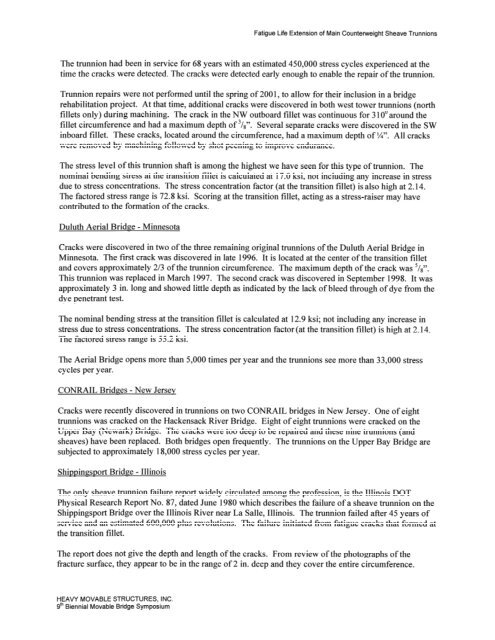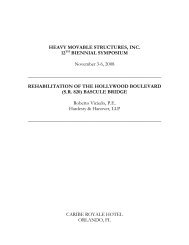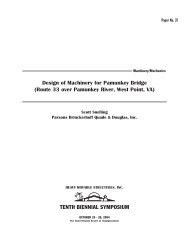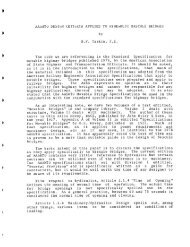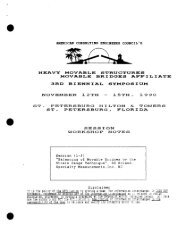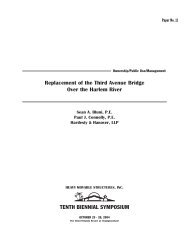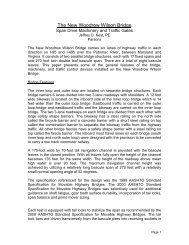Fatigue of Counterweight Sheave Trunnions - Heavy Movable ...
Fatigue of Counterweight Sheave Trunnions - Heavy Movable ...
Fatigue of Counterweight Sheave Trunnions - Heavy Movable ...
You also want an ePaper? Increase the reach of your titles
YUMPU automatically turns print PDFs into web optimized ePapers that Google loves.
<strong>Fatigue</strong> Life Extension <strong>of</strong> Main Countelweight <strong>Sheave</strong> <strong>Trunnions</strong><br />
The trunnion had been in service for 68 years with an estimated 450,000 stress cycles experienced at the<br />
time the cracks were detected. The cracks were detected early enough to enable the repair <strong>of</strong> the trunnion.<br />
Trunnion repairs were not performed until the spring <strong>of</strong> 2001, to allow for their inclusion in a bridge<br />
rehabilitation project. At that time, additional cracks were discovered in both west tower trunnions (north<br />
fillets only) during machining. The crack in the NW outboard fillet was continuous for 3 10' around the<br />
fillet circumference and had a maximum depth <strong>of</strong> 3/8". Several separate cracks were discovered in the SW<br />
inboard fillet. These cracks, located around the circumference, had a maximum depth <strong>of</strong> W. All cracks<br />
were removed by machining followed by shot peening to improve endurance.<br />
The stress level <strong>of</strong> this trunnion shaft is among the highest we have seen for this type <strong>of</strong> trunnion. The<br />
nominal bending stress at the transition fillet is calculated at 17.0 ksi, not including any increase in stress<br />
due to stress concentrations. The stress concentration factor (at the transition fillet) is also high at 2.14.<br />
The factored stress range is 72.8 ksi. Scoring at the transition fillet, acting as a stress-raiser may have<br />
contributed to the formation <strong>of</strong> the cracks.<br />
Duluth Aerial Bridge - Minnesota<br />
Cracks were discovered in two <strong>of</strong> the three remaining original trunnions <strong>of</strong> the Duluth Aerial Bridge in<br />
Minnesota. The first crack was discovered in late 1996. It is located at the center <strong>of</strong> the transition fillet<br />
and covers approximately 213 <strong>of</strong> the trunnion circumference. The maximum depth <strong>of</strong> the crack was 5/8".<br />
This trunnion was replaced in March 1997. The second crack was discovered in September 1998. It was<br />
approximately 3 in. long and showed little depth as indicated by the lack <strong>of</strong> bleed through <strong>of</strong> dye from the<br />
dye penetrant test.<br />
The nominal bending stress at the transition fillet is calculated at 12.9 ksi; not including any increase in<br />
stress due to stress concentrations. The stress concentration factor (at the transition fillet) is high at 2.14.<br />
The factored stress range is 55.2 ksi.<br />
The Aerial Bridge opens more than 5,000 times per year and the trunnions see more than 33,000 stress<br />
cycles per year.<br />
CONRAIL Bridges - New Jersey<br />
Cracks were recently discovered in trunnions on two CONRAIL bridges in New Jersey. One <strong>of</strong> eight<br />
truntlions was cracked on the Hackensack River Bridge. Eight <strong>of</strong> eight trunnions were cracked on the<br />
Upper Bay (Newark) Bridge. The cracks were too deep to be repaired and these nine trunnions (and<br />
sheaves) have been replaced. Both bridges open frequently. The trunnions on the Upper Bay Bridge are<br />
subjected to approximately 18,000 stress cycles per year.<br />
Shippingsport Bridge - Illinois<br />
The only sheave trunnion failure report widely circulated among the pr<strong>of</strong>ession, is the Illinois DOT<br />
Physical Research Report No. 87, dated June 1980 which describes the failure <strong>of</strong> a sheave trunnion on the<br />
Shippingsport Bridge over the Illinois River near La Salle, Illinois. The trunnion failed after 45 years <strong>of</strong><br />
service and an estimated 600,000 plus revolutions. The failure initiated from fatigue cracks that formed at<br />
the transition fillet.<br />
The report does not give the depth and length <strong>of</strong> the cracks. From review <strong>of</strong> the photographs <strong>of</strong> the<br />
fracture surface, they appear to be in the range <strong>of</strong> 2 in. deep and they cover the entire circumference.<br />
HEAVY MOVABLE STRUCTURES, INC.<br />
gth Biennial <strong>Movable</strong> Bridge Symposium


